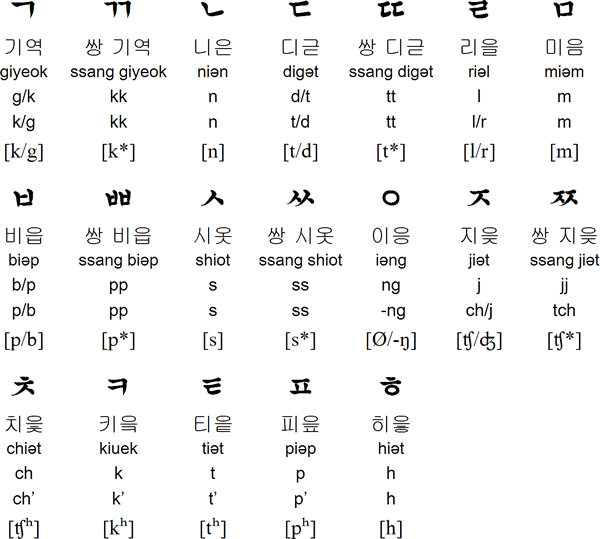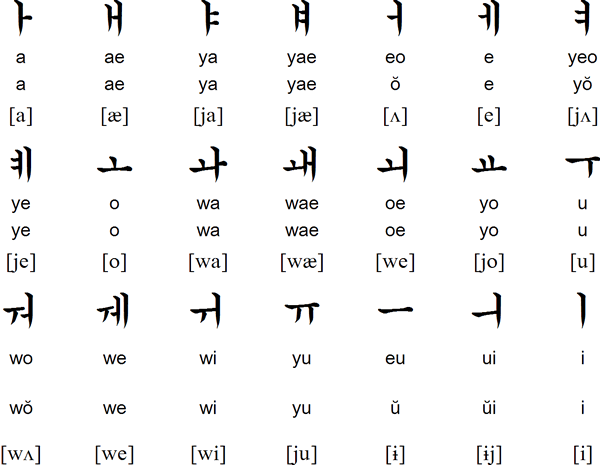About Korean Words/ Hangul
Posted by deewildypark
Korean 
Origin of writing in Korea
Chinese writing has been known in Korea for over 2,000 years. It was used widely during the Chinese occupation of northern Korea from 108 BC to 313 AD. By the 5th century AD, the Koreans were starting to write in Classical Chinese - the earliest known example of this dates from 414 AD. They later devised three different systems for writing Korean with Chinese characters: Hyangchal (향찰/鄕札), Gukyeol (구결/口訣) and Idu (이두/吏讀). These systems were similar to those developed in Japan and were probably used as models by the Japanese.The Idu system used a combination of Chinese characters together with special symbols to indicate Korean verb endings and other grammatical markers, and was used to in official and private documents for many centuries. The Hyangchal system used Chinese characters to represent all the sounds of Korean and was used mainly to write poetry.
The Koreans borrowed a huge number of Chinese words, gave Korean readings and/or meanings to some of the Chinese characters and also invented about 150 new characters, most of which are rare or used mainly for personal or place names.
The Korean alphabet was invented in 1444 and promulgated it in 1446 during the reign of King Sejong (r.1418-1450), the fourth king of the Joseon Dynasty. The alphabet was originally called Hunmin jeongeum, or "The correct sounds for the instruction of the people", but has also been known as Eonmeun (vulgar script) and Gukmeun (national writing). The modern name for the alphabet, Hangeul, was coined by a Korean linguist called Ju Si-gyeong (1876-1914). In North Korea the alphabet is known as 조선글 (josoen guel).
The shapes of the consonants are based on the shape the mouth made when the corresponding sound is made, and the traditional direction of writing (vertically from right to left) most likely came from Chinese, as did the practice of writing syllables in blocks.
Even after the invention of the Korean alphabet, most Koreans who could write continued to write either in Classical Chinese or in Korean using the Gukyeol or Idu systems. The Korean alphabet was associated with people of low status, i.e. women, children and the uneducated. During the 19th and 20th centuries a mixed writing system combining Chinese characters (Hanja) and Hangeul became increasingly popular. Since 1945 however, the importance of Chinese characters in Korean writing has diminished significantly.
Since 1949 hanja have not been used at all in any North Korean publications, with the exception of a few textbooks and specialized books. In the late 1960s the teaching of hanja was reintroduced in North Korean schools however and school children are expected to learn 2,000 characters by the end of high school.
In South Korea school children are expected to learn 1,800 hanja by the end of high school. The proportion of hanja used in Korean texts varies greatly from writer to writer and there is considerable public debate about the role of hanja in Korean writing.
Most modern Korean literature and informal writing is written entirely in hangeul, however academic papers and official documents tend to be written in a mixture of hangeul and hanja.
Notable features of Hangeul
- Type of writing system: alphabet
- Direction of writing: Until the 1980s Korean was usually written from right to left in vertical columns. Since then writing from left to right in horizontal lines has become popular, and today the majority of texts are written horizontally.
- Number of letter: 24 (jamo): 14 consonants and 10 vowels. The letters are combined together into syllable blocks.
- The shapes of the the consontants g/k, n, s, m and ng are graphical representations of the speech organs used to pronounce them. Other consonsants were created by adding extra lines to the basic shapes.
- The shapes of the the vowels are based on three elements: man (a vertical line), earth (a horizontal line) and heaven (a dot). In modern Hangeul the heavenly dot has mutated into a short line.
- Spaces are placed between words, which can be made up of one or more syllables.
- The sounds of some consonants change depending on whether they appear at the beginning, in the middle, or at the end of a syllable.
- A number of Korean scholars have proposed an alternative method of writing Hangeul involving writing each letter in a line like in English, rather than grouping them into syllable blocks, but their efforts have been met with little interest or enthusiasm.
- In South Korea hanja are used to some extent in some Korean texts.
Used to write
Korean (한국어 / 조선말), a language spoken by about 63 million people in South Korea, North Korea, China, Japan, Uzbekistan, Kazakhstan and Russia. The relationship between Korean and other languages is not known for sure, though some linguists believe it to be a member of the Altaic family of languages. Grammatically Korean is very similar to Japanese and about 70% of its vocabulary comes from Chinese.The Hangeul alphabet (한글)

The double consonants marked with * are pronounced fortis. There is no symbol in IPA to indiciate this.

Note on the transliteration of Korean
There are a number different ways to write Korean in the Latin alphabet. The methods shown above are:- (first row) the official South Korean transliteration system, which was introduced in July 2000. You can find further details at www.mct.go.kr.
- (second row) the McCune-Reischauer system, which was devised in 1937 by two American graduate students, George McCune and Edwin Reischauer, and is widely used in Western publications. For more details of this system see: http://mccune-reischauer.org
Download
Download a Korean alphabet chart in Word or PDF format (letters arranged in South Korean order but without the double consonants).Sample text in Korean (hangeul only)

Sample text in Korean (hangeul and hanja)

Transliteration
Modeun Ingan-eun Tae-eonal ttaebuteo Jayuroumyeo Geu Jon-eomgwa Gwonrie Iss-eo Dongdeunghada. Ingan-eun Cheonbujeog-euro Iseong-gwa Yangsim-eul Bu-yeobad-ass-eumyeo Seoro Hyungje-ae-ui Jeongsin-euro Haengdongha-yeo-yahanda.Hear a recording of this text
Translation
All human beings are born free and equal in dignity and rights. They are endowed with reason and conscience and should act towards one another in a spirit of brotherhood.(Article 1 of the Universal Declaration of Human Rights)
Tower of Babel in Korean | Useful phrases in Korean
Links
Information about the Korean languagehttp://ling.kgw.tu-berlin.de/Korean/Artikel01/Korean.htm
http://en.wikipedia.org/wiki/Korean_language
Online Korean lessons
http://korean.sogang.ac.kr
http://rki.kbs.co.kr/learn_korean/lessons/e_index.htm
http://www.langintro.com/kintro/
http://www.learnkorean.com
http://www.interedu.go.kr
http://www.lifeinkorea.com/Language/korean.cfm
http://www.declan-software.com/korean.htm
http://hangulforest.com/index_e.htm
http://learnkorean.elanguageschool.net
http://english.visitkorea.or.kr/enu/CU/CU_EN_8_6_1_1_1.jsp
http://www.rocketlanguages.com/korean/premium/
Learn to read, write and pronounce Korean
http://www.learnlangs.com/RWP/Korean/
Transliterate Korean
http://sori.org/hangul/conv2kr.cgi
Korean Flashcards
http://www.korean-flashcards.com
Free Korean fonts
http://www.wazu.jp/gallery/Fonts_Korean.html
http://ssessesse.x-y.net/acsesarymenu/font/hanfont1.htm
http://babel.uoregon.edu/yamada/fonts/korean.html
Korean language schools, vocabulary and other resources
http://www.korean-language.org
Online Korean dictionaries
http://www.websters-online-dictionary.org/
definition/Korean-english/
http://dic.yahoo.co.kr
http://bluedic.com
http://dic.impact.pe.kr
Korean Electronic talking dictionaries
http://www.ectaco.com
English names in Korean
http://thinkzone.wlonk.com/Language/KoreanName.htm
Online Korean radio
http://rki.kbs.co.kr
http://www.rfa.org/korean/
Korean Ministry of Culture & Tourism - information in Korean, English, Chinese and Japanese about Korean history, language, literature, etc: http://www.mct.go.kr/
Online Korean news
http://www.chosun.com
http://www.dongailbo.co.kr
http://www.hani.co.kr
http://www.m2000.co.kr
http://www.munhwa.com
korean directory : zkorean directory


http://www.korean-language.org/korean/dialects.asp
ReplyDelete